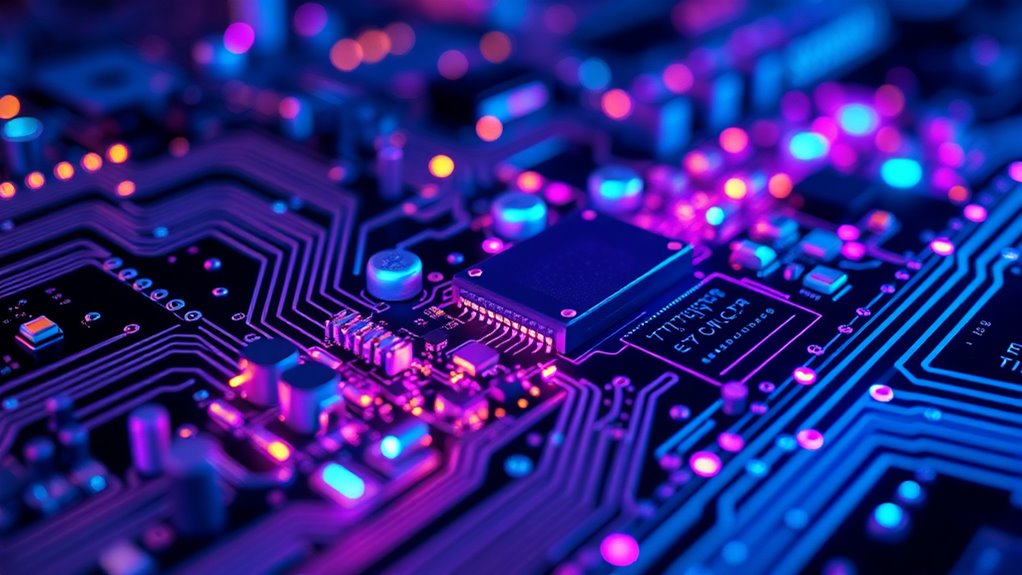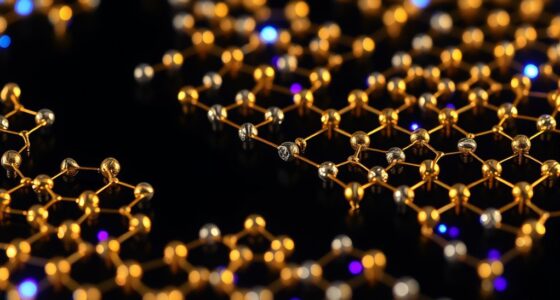Nanophotonics is transforming future electronics by enabling you to manipulate light at nanometer scales, making devices smaller, faster, and more energy-efficient. By using tiny structures like quantum dots and plasmonic materials, you can achieve precise control over light-matter interactions, boosting device performance. This technology paves the way for breakthroughs in quantum computing, high-speed communication, and advanced sensors. Keep exploring to discover how these innovations will shape the electronics you use every day.
Key Takeaways
- Nanophotonics enables manipulation of light at nanoscales, leading to more compact and energy-efficient electronic devices.
- Integration of quantum dots with plasmonic structures enhances light emission, detection, and device performance.
- These technologies facilitate the development of ultra-compact lasers, sensors, and quantum computing components.
- Future electronics will benefit from nanoscale control over light-matter interactions, increasing speed and reducing power consumption.
- Ongoing research aims to utilize novel materials and fabrication techniques for advanced, miniaturized photonic-electronic systems.

Nanophotonics, the study of light manipulation at nanometer scales, is poised to revolutionize the future of electronics. By harnessing phenomena that occur at tiny dimensions, you’ll find new ways to control light and matter with unprecedented precision. Two key players in this field are quantum dots and plasmonic structures. These nanoscale components open new doors for compact, efficient, and faster electronic devices.
Quantum dots are tiny semiconductor particles, only a few nanometers in size, that can emit or absorb light at specific wavelengths. Their size-dependent optical properties make them incredibly versatile. When integrated into electronic systems, quantum dots serve as highly efficient emitters or detectors, enabling you to develop advanced displays, solar cells, and photodetectors. Because they can be tuned to particular wavelengths simply by adjusting their size, quantum dots allow for precise control over light-matter interactions at the nanoscale. This control translates into devices that are not only smaller but also more energy-efficient, with capabilities beyond traditional materials.
Plasmonic structures, on the other hand, consist of metals like gold or silver that support surface plasmon resonances—collective oscillations of electrons stimulated by light. When you incorporate plasmonic structures into your nanophotonic designs, you markedly amplify local electromagnetic fields. This enhancement allows you to concentrate light into tiny volumes, increasing the interaction between light and matter. As a result, plasmonic structures can boost the sensitivity of sensors, improve the efficiency of energy transfer in photovoltaic devices, and enable faster data processing. Their ability to manipulate light at sub-wavelength scales means you can push the boundaries of miniaturization while maintaining or even surpassing the performance of larger components.
Together, quantum dots and plasmonic structures form a powerful duo in nanophotonics. Quantum dots provide tunable, efficient light sources and detectors, while plasmonic structures enhance light-matter interactions, boosting device performance. When you combine these elements, you’re creating opportunities for next-generation electronics that are smaller, faster, and more energy-efficient. For example, integrating quantum dots with plasmonic antennas can lead to highly sensitive biosensors or ultra-compact lasers. The synergy between these nanostructures opens pathways for innovations in quantum computing, ultra-fast communication, and advanced imaging.
As you explore the frontiers of nanophotonics, you’ll see how these nanoscale structures transform your approach to electronics. They enable the development of devices that leverage the quantum nature of light and matter, pushing technology beyond the limits of conventional electronics. The future you’re shaping with nanophotonics promises more powerful, efficient, and miniaturized systems that will redefine how you process and utilize information. Additionally, ongoing research into alternative materials and fabrication techniques continues to expand the potential applications of nanophotonics in electronics.
Frequently Asked Questions
How Will Nanophotonics Impact Consumer Electronics Affordability?
Nanophotonics will make consumer electronics more affordable by enabling cost reduction through more efficient manufacturing processes. It also promotes device miniaturization, allowing smaller, more powerful gadgets that cost less to produce and buy. As technology advances, you’ll see cheaper, more compact devices with better performance. This combination of cost savings and miniaturization will make innovative electronics accessible to a broader audience, transforming your everyday tech experience.
What Are the Environmental Implications of Nanophotonics Manufacturing?
You should know that nanophotonics manufacturing can substantially impact the environment, with studies showing that sustainable manufacturing practices reduce waste by up to 30%. By adopting eco-friendly methods, you help minimize hazardous waste and energy consumption. This approach promotes waste reduction and lessens pollution, making nanophotonics a greener technology. Embracing sustainable manufacturing ensures that advancements benefit both society and the planet, aligning innovation with environmental responsibility.
Can Nanophotonics Improve Wireless Communication Security?
Yes, nanophotonics can improve wireless communication security by enabling quantum encryption, which makes data virtually unhackable. It enhances signal integrity by controlling light at the nanoscale, reducing interference and eavesdropping risks. By integrating nanophotonics, you can develop more secure, faster wireless networks, protecting sensitive information effectively. This technology’s precision guarantees your communications remain private, reliable, and resistant to cyber threats.
What Challenges Exist in Integrating Nanophotonics With Traditional Electronics?
You face significant challenges when integrating nanophotonics with traditional electronics. About 60% of researchers cite scalability issues as a primary obstacle, making mass production difficult. Fabrication challenges, like achieving precise nanoscale structures, also hinder seamless integration. These hurdles slow down development and increase costs, but overcoming them promises breakthroughs in faster, more efficient devices. Addressing these issues is essential for enabling the full potential of nanophotonics in electronics.
How Soon Will Nanophotonics-Enabled Devices Become Commercially Available?
You can expect nanophotonics-enabled devices to become commercially available within the next 5 to 10 years. Advances in quantum dots and plasmonics applications accelerate this timeline, as they improve device efficiency and integration. While some products are already emerging, widespread adoption depends on overcoming manufacturing challenges and ensuring cost-effectiveness. Keep an eye on industry developments, as rapid progress suggests these innovative devices will soon become part of everyday technology.
Conclusion
As you explore nanophotonics, you’re shaping the building blocks of future electronics, like a skilled architect designing a miniature city. This field acts as a bridge, guiding light through tiny channels to revolutionize how devices communicate and operate. Embracing these innovations, you’re revealing a universe where photon-based technologies transform the landscape of electronics, illuminating pathways toward faster, smaller, and more efficient systems. The future of electronics is a delicate dance of light and matter, waiting for your touch.









